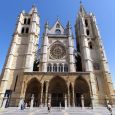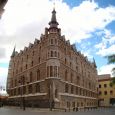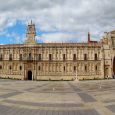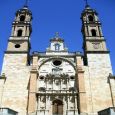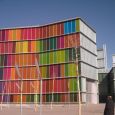Leon
Advertisement
By air
Leon Airport is located approximately 6 kilometers away from the downtown part of the city, in the neighboring town of La Virgen Del Camino/Valverde de la Virgen. It offers mostly domestic flights within the country, as well as flights to and from Paris, France. Currently two Spanish airlines operate in it: Iberia/Air Nostrum and Air Europa. They offer flights from and to Madrid, Spain, Barcelona, Spain, Valencia, Spain, Palma de Mallorca, Spain, Tenerife, Spain and Paris, France. During the summer months the number of available destinations increases, and flights are also offered from and to Ibiza, Spain, Menorca, Spain, Malaga, Spain and Gran Canaria, Spain.
By Train
Trains also leave depart from Atocha and from Chamartin to Leon several times a day.Starting in 2008 it is possible to travel by train from Madrid in aprox. 3 hours thanks to a new generation of fast trains . For those landing in Valladolid there is a convenient fast train taking less than two hours to Leon.There is also a direct train connection to Pontevedra and Barcelona.
By Bus
From Madrid Buses leave from Estacion Sur de Autobuses at the metro station Mendez alvaro as well as "Avenida de America" several times a day, a round trip costs between 20€ and 40€ per person.There are also a couple buses per day that leave at Moncloa station in Madrid.
Leon Cathedral
Santa Maria de Leon Cathedral, also called The House of Light or the Pulchra Leonina is situated in the city of Leon in north-western Spain. It was built on the site of previous Roman baths of the 2nd century which, 800 years later, king Ordono II converted into a palace.The Leon Cathedral, dedicated to Santa Maria de la Regla, was declared of Cultural Interest in 1844. It is known as the Pulchra Leonina and is a masterpiece of the Gothic style dominating the mid-13th century, by master architect Enrique. By the late 16th century it was virtually completed.
Basilica of San Isidoro
The Basilica of San Isidoro is a church in Leon, Spain, located on the site of an ancient Roman temple. Its Christian roots can be traced back to the early 10th century when a monastery for Saint John the Baptist was erected on the grounds.In 1063 the basilica was rededicated to Saint Isidore of Seville. Isidore was archbishop of Seville, and the most celebrated academic and theologian of Visigothic Spain in the period preceding the Arab invasions. With the agreement of Abbad II al-Mu'tadid, the Muslim ruler of Seville, Isidore's relics were brought to Leon where they could be interred on Christian soil. The tomb of the saint still draws many visitors today. An equestrian statue of Santiago Matamoros is visible, along with many other sculptures, high on the facade.
Convent of San Marcos
The convent of San Marcos in Leon, Spain is today an operating luxury parador hotel. It also contains a consecrated church and museum, and is one of the most important monuments of the Renaissance in Spain. It is one of the greatest architectural jewels of Leon, together with the Cathedral, the Basilica of San Isidoro and la Casa Botines. It has a highly ornamental plateresque facade.
Palacio de los Guzmanes
The Palacio de los Guzmanes is a Renaissance building in the city of Leon it is the seat of Provincial Government of Leon.The architect Rodrigo Gil de Hontanon built the palace in the 16th century, commissioned by the aristocratic family of Guzman.
Casa de los Botines
The Casa de los Botines (built 1892-1893) is a Modernist building in Leon, Spain designed by Antoni Gaudi. Today, it serves as the headquarters of the Caja Espana bank.While Gaudi was finishing the construction of the Episcopal Palace of Astorga, his friend and patron, Eusebi Guell recommended that he build a house in the center of Leon. Simon Fernandez and Mariano Andres, the owners of a company that bought fabrics from Guell, commissioned Gaudi to build a residential building with a warehouse. The house's nickname comes from the last name of the company's former owner, Joan Homs i Botinàs.
Museo de Arte Contemporaneo de Castilla y Leon
The Museo de Arte Contemporaneo de Castilla y Leon, better known as the MUSAC, is a contemporary art museum in the city of Leon, Spain.Inaugurated in April 2005 by Felipe, Prince of Asturias, this cultural institution aims to be a "Museum of the Present", in the words of its curator Agustin Perez Rubio, and thus only collects artworks from the latest generation of artists, between 1992 and 2012 . The museum has won international prestige for its 21st-century collection and innovative programming, being labelled, for example, as "one of the most astonishingly bold museums to hit the Spanish cultural landscape in years" by The New York Times.The MUSAC building is celebrated for its avant-garde architecture, and it has been awarded a number of prizes, such as the 2007 European Union Prize for Contemporary Architecture . Designed by the architectural studio of Luis M.
San Juan y San Pedro de Renuev
San Juan y San Pedro de Renueva is a church in Leon, central Spain.It was built in the mid-20th century in Neo-Renaissance style by will of the local bishop, Luis Almarcha Hernandez. Its main artistical feature is the entrance gate, in Baroque style, taken from the ruined monastery of San Pedro de Eslonza, located 22 km outside Leon in the municipality of Gradefes. It dates from 1711 and was designed by the archictect Pedro Martinez de Cardena. It has three orders, the first characterized by four Ionic columns over pedestals, the second similar to the former, apart the use of Corinthian columns and the narrower length. It is sided by two circular windows, and surmounted by another one over a coat of arms. The facade ha five niches, now empty, but originally housing statues of saints.
March - May
October - November


